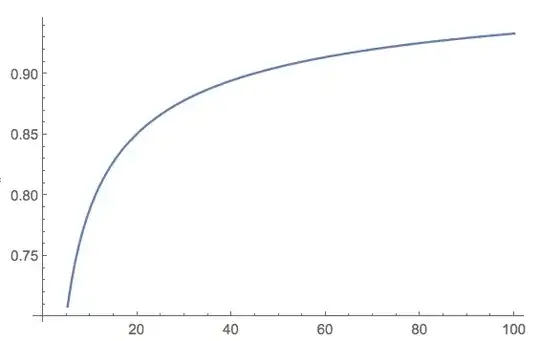$\newcommand{\bbx}[1]{\,\bbox[15px,border:1px groove navy]{\displaystyle{#1}}\,}
\newcommand{\braces}[1]{\left\lbrace\,{#1}\,\right\rbrace}
\newcommand{\bracks}[1]{\left\lbrack\,{#1}\,\right\rbrack}
\newcommand{\dd}{\mathrm{d}}
\newcommand{\ds}[1]{\displaystyle{#1}}
\newcommand{\expo}[1]{\,\mathrm{e}^{#1}\,}
\newcommand{\ic}{\mathrm{i}}
\newcommand{\mc}[1]{\mathcal{#1}}
\newcommand{\mrm}[1]{\mathrm{#1}}
\newcommand{\pars}[1]{\left(\,{#1}\,\right)}
\newcommand{\partiald}[3][]{\frac{\partial^{#1} #2}{\partial #3^{#1}}}
\newcommand{\root}[2][]{\,\sqrt[#1]{\,{#2}\,}\,}
\newcommand{\totald}[3][]{\frac{\mathrm{d}^{#1} #2}{\mathrm{d} #3^{#1}}}
\newcommand{\verts}[1]{\left\vert\,{#1}\,\right\vert}$
Hereafter I'll use
Iverson Bracket which is a convenient 'tool' to handle constraints. Namely, $\ds{\bracks{P}}$ is equal to $\ds{\color{red}{ONE}}$ whenever $\ds{P}$ proposition is $\ds{\large\texttt{true}}$ and $\ds{\color{red}{ZERO}}$ otherwise.
\begin{align}
&\bbox[10px,#ffd]{\ds{{1 \over 2n}\int_{-n}^{n}{1 \over 2n}
\int_{-n}^{n}\bracks{B^{2} - 4C \geq 0}\dd B\,\dd C}} =
{1 \over 2n^{2}}\int_{0}^{n}
\int_{-n}^{n}\bracks{C \leq {B^{2} \over 4}}\dd C\,\dd B
\\[5mm] & =
{1 \over 2n^{2}}\int_{0}^{n}
\int_{0}^{n}\braces{\bracks{C \leq {B^{2} \over 4}} +
\bracks{-C \leq {B^{2} \over 4}}}\dd C\,\dd B
\\[5mm] & =
{1 \over 2n^{2}}\int_{0}^{n}
\braces{\bracks{{B^{2} \over 4} < n}\int_{0}^{B^{2}/4}\dd C +
\bracks{{B^{2} \over 4} \geq n}\int_{0}^{n}\dd C + n}\dd B
\\[5mm] & =
{1 \over 2n^{2}}\int_{0}^{n}
\braces{\bracks{B < 2\root{n}}{B^{2} \over 4} +
\bracks{B \geq 2\root{n}}n}\dd B + {1 \over 2}
\\[5mm] & =
{1 \over 8n^{2}}\int_{0}^{n}\bracks{B < 2\root{n}}B^{2}\,\dd B +
{1 \over 2n}\int_{0}^{n}\bracks{B \geq 2\root{n}}\,\dd B + {1 \over 2}
\\[1cm] & =
{\bracks{2\root{n} \leq n} \over 8n^{2}}\int_{0}^{2\root{n}}B^{2}\,\dd B +
{\bracks{2\root{n} > n} \over 8n^{2}}\int_{0}^{n}B^{2}\,\dd B
\\[2mm] &
+ {\bracks{2\root{n} \leq n} \over 2n}\int_{2\root{n}}^{n}\,\dd B + {1 \over 2}
\\[1cm] & =
{\bracks{n \geq 4} \over 3\root{n}} + \bracks{n < 4}\,{n \over 24} +
\bracks{n \geq 4}\,{n - 2\root{n} \over 2n} + {1 \over 2}
\\[5mm] & =
{1 \over 2} + \bracks{n < 4}{n \over 24} + \bracks{n \geq 4}\pars{{1 \over 2} -
{2 \over 3\root{n}}}
\\[5mm] & =
\bbx{\bracks{n < 4}\pars{{1 \over 2} + {n \over 24}} +
\bracks{n \geq 4}\pars{1 - {2 \over 3\root{n}}}}
\end{align}

